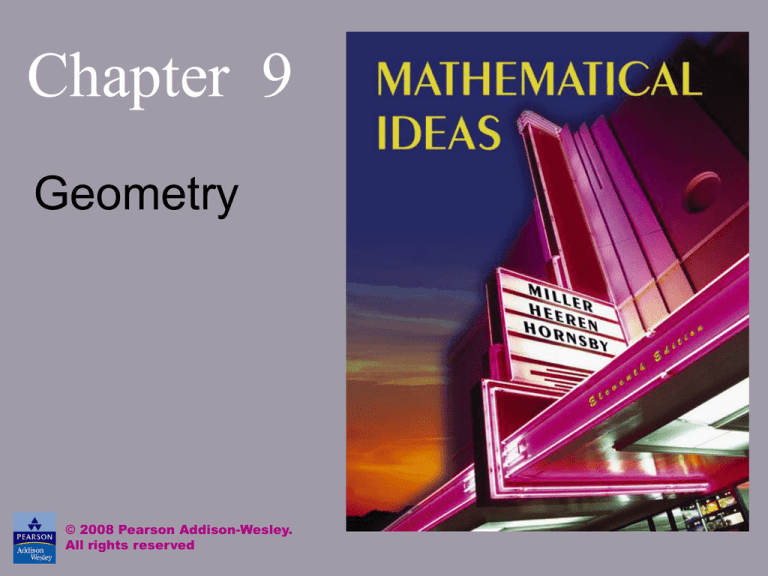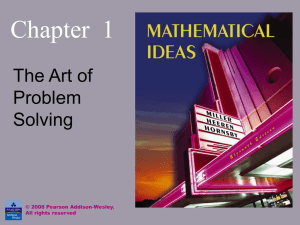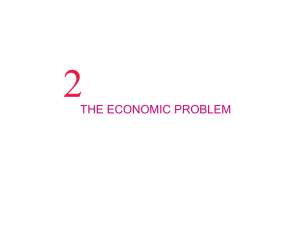
Chapter 9
Geometry
© 2008 Pearson Addison-Wesley.
All rights reserved
Chapter 9: Geometry
9.1
9.2
9.3
9.4
9.5
9.6
9.7
9.8
Points, Lines, Planes, and Angles
Curves, Polygons, and Circles
Perimeter, Area, and Circumference
The Geometry of Triangles: Congruence,
Similarity, and the Pythagorean Theorem
Space Figures, Volume, and Surface Area
Transformational Geometry
Non-Euclidean Geometry, Topology, and Networks
Chaos and Fractal Geometry
9-2-2
© 2008 Pearson Addison-Wesley. All rights reserved
Chapter 1
Section 9-2
Curves, Polygons, and Circles
9-2-3
© 2008 Pearson Addison-Wesley. All rights reserved
Curves, Polygons, and Circles
• Curves
• Triangles and Quadrilaterals
• Circles
9-2-4
© 2008 Pearson Addison-Wesley. All rights reserved
Curves
The basic undefined term curve is used for
describing figures in the plane.
9-2-5
© 2008 Pearson Addison-Wesley. All rights reserved
Simple Curve; Closed Curve
A simple curve can be drawn without
lifting the pencil from the paper, and
without passing through any point twice.
A closed curve has its starting and
ending points the same, and is also drawn
without lifting the pencil from the paper.
9-2-6
© 2008 Pearson Addison-Wesley. All rights reserved
Simple Curve; Closed Curve
Simple;
closed
Simple; not
closed
Not simple;
closed
Not simple;
not closed
9-2-7
© 2008 Pearson Addison-Wesley. All rights reserved
Convex
A figure is said to be convex if, for any two
points A and B inside the figure, the line
segment AB is always completely inside the
figure.
A
A
B
B
Convex
Not convex
9-2-8
© 2008 Pearson Addison-Wesley. All rights reserved
Polygons
A polygon is a simple, closed curve made up
of only straight line segments. The line
segments are called sides, and the points at
which the sides meet are called vertices.
Polygons with all sides equal and all angles
equal are regular polygons.
9-2-9
© 2008 Pearson Addison-Wesley. All rights reserved
Polygons
Convex
Not convex
Regular Polygons
9-2-10
© 2008 Pearson Addison-Wesley. All rights reserved
Classification of Polygons According
to Number of Sides
Number of Sides
3
4
5
6
7
8
9
10
Name
Triangle
Quadrilateral
Pentagon
Hexagon
Heptagon
Octagon
Nonagon
Decagon
© 2008 Pearson Addison-Wesley. All rights reserved
9-2-11
Types of Triangles - Angles
All Angles
Acute
One Right
Angle
One Obtuse
Angle
Acute Triangle Right Triangle Obtuse
Triangle
9-2-12
© 2008 Pearson Addison-Wesley. All rights reserved
Types of Triangles - Sides
All Sides
Equal
Two Sides
Equal
No Sides
Equal
Equilateral
Triangle
Isosceles
Triangle
Scalene
Triangle
9-2-13
© 2008 Pearson Addison-Wesley. All rights reserved
Types of Quadrilaterals
A trapezoid is a quadrilateral with
one pair of parallel sides.
A parallelogram is a quadrilateral
with two pairs of parallel sides.
A rectangle is a parallelogram with a
right angle.
9-2-14
© 2008 Pearson Addison-Wesley. All rights reserved
Types of Quadrilaterals
A square is a rectangle with all sides
having equal length.
A rhombus is a parallelogram with
all sides having equal length.
9-2-15
© 2008 Pearson Addison-Wesley. All rights reserved
Angle Sum of a Triangle
The sum of the measures of the angles of any
triangle is 180°.
9-2-16
© 2008 Pearson Addison-Wesley. All rights reserved
Example: Finding Angle Measures in
a Triangle
Find the measure of each angle in the triangle below.
x°
Solution
(x+20)°
(220 – 3x)°
x + x + 20 + 220 – 3x = 180
–x + 240 = 180
x = 60
Evaluating each expression we find that the
angles are 60°, 80° and 40°.
9-2-17
© 2008 Pearson Addison-Wesley. All rights reserved
Exterior Angle Measure
The measure of an exterior angle of a triangle
is equal to the sum of the measures of the two
opposite interior angles.
2
4
1
3
The measure of angle 4 is equal to the sum of
the measures of angles 2 and 3 Two other
statements can be made.
© 2008 Pearson Addison-Wesley. All rights reserved
9-2-18
Example: Finding Angle Measures in
a Triangle
Find the measure of the exterior indicated below.
(x+20)°
(3x – 40)°
Solution
x°
x + x + 20 = 3x – 40
2x + 20 = 3x – 40
x = 60
Evaluating the expression we find that the
exterior angle is 3(60) – 40 =140°.
9-2-19
© 2008 Pearson Addison-Wesley. All rights reserved
Circle
A circle is a set of points in a plane, each
of which is the same distance from a fixed
point (called the center).
9-2-20
© 2008 Pearson Addison-Wesley. All rights reserved
Circle
A segment with an endpoint at the center and an
endpoint on the circle is called a radius (plural: radii).
A segment with endpoints on the circle is called a
chord.
A segment passing through the center, with endpoints
on the circle, is called a diameter. A diameter divides
a circle into two equal semicircles.
A line that touches a circle in only one point is called a
tangent to the circle. A line that intersects a circle in
two points is called a secant line.
9-2-21
© 2008 Pearson Addison-Wesley. All rights reserved
Circle
P
PR is a diameter.
O is the center
OQ is a radius.
PQ is a secant line.
Q
O
R
PQ is a chord.
PQ is an arc.
T
RT is a tangent line.
9-2-22
© 2008 Pearson Addison-Wesley. All rights reserved
Inscribed Angle
Any angle inscribed in a semicircle must
be a right angle.
To be inscribed in a semicircle, the vertex of the
angle must be on the circle with the sides of the
angle going through the endpoints of the diameter at
the base of the semicircle.
9-2-23
© 2008 Pearson Addison-Wesley. All rights reserved








